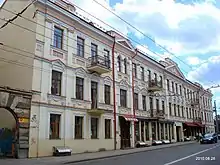Vilna Rabbinical School and Teachers' Seminary
The Vilna Rabbinical School and Teachers' Seminary was a controversial Russian state-sponsored institution to train Jewish teachers and rabbis, located in Vilna, Russian Empire. The school opened in 1847 with two divisions: a rabbinical school and a teachers' seminary.[1] The Rabbinical School was closed in 1873 and the Teachers' Seminary closed in 1914.[1] The school taught secular studies, unlike the traditional cheders and yeshivas. This new curriculum, as well as the government control, made the school "unpopular."[1]

Curriculum
The school taught German language, Hebrew language, Hebrew Bible, Talmud,[2] algebra, geometry, trigonometry, physics, astronomy, world history, Russian history, Russian language, geography, and handwriting and drawing.[3]
History
Rabbi Yisroel Salanter, a major figure of the Mussar movement who then lived in Vilna, was pressured to lead the seminary. Rather than accept the position, Salanter fled[4] to Kovno, even though Rabbi Yitzhak of Volozhin encouraged him to take the position.[5]
In 1872, a secret Narodnik[6] study group was formed[7] by Aaron Zundelevich. Vladimir Jochelson was a member of this group.[8]
Faculty and students
Many prominent[2] maskilim studied or taught in the school.[9]
Notable faculty included:
- Leibele Antokolier (a.k.a. Arieh-Leib b. Akiba Luria, "The Keidan Genius")[10]
- Shmuel Yosef Feunn (author, maskil, and educator)[11]
- Aaron Samuel Liebermann[12]
- Solomon Salkind (1806 – March 14, 1868), author of Shirim li-Shelomoh, Kol Shelomoh, and Shema Shelomoh.[13]
Notable students included:
- Vladimir Jochelson, Russian ethnographer[8]
Weblinks
Vilna Rabbinical School and Teachers' Seminary 1847-1873 The Edward Blank YIVO Vilna Online Collections Original documents (Russian) on vilnacollections.yivo.org
References
- Mohrer, Fruma; Marek Web (October 1997). Guide to the YIVO Archives. YIVO Archives. M.E. Sharpe. p. 226. ISBN 0-7656-0130-3. Retrieved August 17, 2009.
- Murav, Harriet (May 14, 2003). Identity Theft: the Jew in imperial Russia and the case of Avraam Uri Kovner (1 ed.). Stanford University Press. pp. 16–17. ISBN 0-8047-3290-6. Retrieved August 17, 2009.
- "Pages from a certificate issued by the rabbinical seminary to 20-year-old from Antokol, Vilna". Center for Jewish History. Retrieved 2009-08-17.
- Levenson, Alan T.; Roger C. Klein (February 28, 2006). An introduction to modern Jewish thinkers: from Spinoza to Soloveitchik (2 ed.). Rowman & Littlefield Publishers, Inc. p. 168. ISBN 0-7425-4607-1.
- Kantor, Máttis (February 2007). Codex Judaica: chronological index of Jewish history, covering 5,764 years (3 ed.). Zichron Press. p. 266. ISBN 978-0-9670378-3-7. Retrieved August 17, 2009.
- Beĭzer, Mikhail; Martin Gilbert (May 1989). The Jews of St. Petersburg: excursions through a noble past (1 ed.). Jewish Publication Society of America. p. 129. ISBN 0-8276-0321-5. Retrieved August 17, 2009.
- Zipperstein, Steven J. (November 1, 1991). The Jews of Odessa: A Cultural History, 1794–1881. Stanford University Press. p. 118. ISBN 0-8047-1962-4. Retrieved August 17, 2009.
- Jacobs, Jack (August 1, 1993). On Socialists and "the Jewish Question" after Marx. New York: NYU Press. p. 179. ISBN 0-8147-4213-0. Retrieved August 17, 2009.
- Abramowicz, Hirsz (March 1999). Jeffrey Shandler (ed.). Profiles of a lost world: memoirs of East European Jewish life before World. Wayne State University Press. p. 14. ISBN 0-8143-2784-2.
- Kagan, Berl (1991). Jewish Cities, Towns, and Rural Settlements in Lithuania. New York.
- Fishman, David E. (November 28, 2005). The rise of modern Yiddish culture (1 ed.). University of Pittsburgh Press. p. 116. ISBN 0-8229-4272-0.
- "Jewish Community of Vilna". The Museum of the Jewish People at Beit Hatfutsot. Retrieved 2009-08-17.
- Singer, Isidore; M. Seligsohn. "SALKIND, SOLOMON BEN BARUCH". JewishEncyclopedia.com. Retrieved 2009-08-17.
External links
- The Jews of Vilna at the Beginning of the 20th Century on the Yad Vashem website